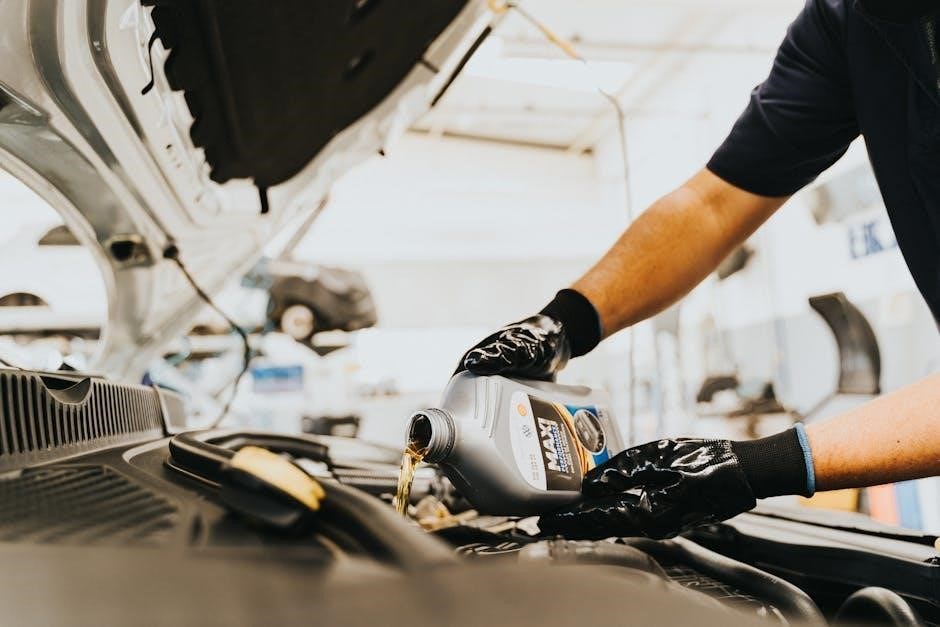Regular manual gearbox oil changes are essential for maintaining smooth gear operation and preventing corrosion. Fresh oil ensures proper lubrication, reducing wear and extending gearbox lifespan.
1.1 Importance of Regular Gearbox Oil Changes
Regular gearbox oil changes are crucial for maintaining optimal performance and longevity. Over time, the oil degrades, losing its lubricating properties and ability to protect moving parts. Dirty or worn-out oil can lead to premature wear, corrosion, and potentially catastrophic gearbox failure. Fresh oil ensures smooth gear engagement, reduces friction, and prevents overheating. Neglecting oil changes can result in costly repairs, such as replacing damaged gears or bearings. Additionally, clean oil helps prevent contaminants like metal shavings from causing further damage. Regular maintenance also enhances shifting smoothness and overall drivetrain efficiency, making it a vital part of car care.
1.2 Frequency of Oil Changes for Manual Gearboxes
The frequency of manual gearbox oil changes varies depending on driving conditions and manufacturer recommendations. Typically, it’s advised every 30,000 to 60,000 miles. Severe driving, such as frequent stop-and-go traffic or extreme temperatures, may require changes as often as every 30,000 miles. For normal driving conditions, extending up to 60,000 miles is common. Synthetic oils may last longer, but always follow the vehicle’s specific guidelines. Regular changes prevent wear and corrosion, ensuring smooth gear operation and longevity. Check your owner’s manual or consult a mechanic for precise intervals tailored to your vehicle and usage patterns.

Choosing the Correct Gearbox Oil
Selecting the right gearbox oil is crucial for optimal performance. Common types include ATF, GL-4, and GL-5, depending on manufacturer specifications. Red Line and Comma are popular choices.
2.1 Understanding Gearbox Oil Specifications (e.g., GL-4, GL-5, ATF)
Gearbox oil specifications like GL-4, GL-5, and ATF indicate the oil’s performance characteristics. GL-4 is designed for manual transmissions with light to moderate loads, while GL-5 is heavier and suited for high-stress applications. ATF (Automatic Transmission Fluid) is typically used in automatic gearboxes but may be specified for some manual transmissions, like the Type 9 gearbox. Using the correct specification ensures proper lubrication, prevents wear, and avoids damage. Incorrect oil can lead to gearbox failure or poor performance. Always consult your vehicle’s manual to confirm the recommended specification before changing the oil.
2.2 Recommended Oil Types for Manual Gearboxes (e.g., Red Line, Comma)
For manual gearboxes, high-quality oils like Red Line Lightweight or Comma GO45 are recommended. These oils meet GL-4 specifications, ensuring excellent wear protection and smooth gear operation. Red Line Lightweight is ideal for high-performance applications, offering superior thermal stability and friction reduction. Comma GO45 is a cost-effective option with excellent lubrication properties. Both oils are compatible with most manual transmissions and provide long-lasting protection against corrosion and wear. Always consult your vehicle’s manual to confirm the correct viscosity and specification. For some gearboxes, ATF (Automatic Transmission Fluid) may also be specified, especially in older models. Avoid using engine oil, as it may not meet gearbox requirements.

Tools and Materials Needed
Essential tools include a drain pan, socket or wrench, and filler tool. Materials needed are new gearbox oil, safety gloves, and rags for cleanup.
- Drain pan
- Socket or wrench
- Filler tool (e.g., oil pump or syringe)
- New gearbox oil (correct specification)
- Safety gloves and goggles
- Rags
3.1 Essential Tools for Draining and Refilling
To perform a manual gearbox oil change, you’ll need specific tools to ensure the process is efficient and mess-free. Start with a drain pan to catch the old oil, a socket wrench or ratchet for removing the drain and fill plugs, and a pair of gloves for protection. A small oil pump or syringe is handy for refilling, especially if the fill hole is hard to reach. Additionally, have new oil filters ready if your gearbox requires them, and keep rags on hand to clean spills. Safety equipment like goggles and gloves is crucial to protect yourself from oil splashes and sharp edges.
3.2 Safety Equipment and Materials

When performing a manual gearbox oil change, it’s crucial to use appropriate safety equipment to protect yourself and ensure the process is done safely. Always wear gloves and goggles to prevent skin and eye contact with old oil. A drain pan is essential for catching the old oil to avoid spills and make cleanup easier. Additionally, have rags on hand to wipe down surfaces and tools. A pair of ramps or jack stands can help elevate the vehicle safely, providing better access to the gearbox. Finally, keep a funnel nearby to prevent spills when refilling with new oil.

Steps to Change Manual Gearbox Oil
- Loosen the filler/level plug before removing the drain plug to avoid airlocks.
- Drain the old oil completely into a pan and clean the drain plug.
- Refill with the recommended oil type until it dribbles out the fill plug.
- Replace both plugs securely and dispose of used oil responsibly.
4;1 Draining the Old Oil
To drain the old oil, locate the gearbox drain plug, typically at the bottom. Position a drip tray or oil pan underneath. Loosen the plug using a socket wrench. Allow the oil to flow out completely before replacing the plug. Ensure the area is clean to prevent contamination. Always refer to your vehicle’s manual for specific instructions, as drain plug locations may vary. Properly dispose of the used oil responsibly. This step is crucial for ensuring the new oil performs effectively.
4.2 Refilling with New Oil
After draining the old oil, prepare the new gearbox oil and ensure the area around the fill plug is clean to prevent contamination. Use a small oil pump or syringe to pour the new oil into the gearbox through the fill plug. Fill until the oil starts to drip out of the plug, indicating the gearbox is sufficiently lubricated. Replace the fill plug securely and wipe any spills with a clean cloth. Double-check the oil level by monitoring the drip from the fill plug. Once satisfied, tighten all plugs and dispose of any rags or materials used responsibly. Always refer to your vehicle’s manual for the correct oil capacity to avoid overfilling.

Additional Tips and Considerations
Clean the drain plug and fill plug thoroughly before reinstallation. Use an oil pump or syringe for precise refilling. Always check for leaks after refilling the gearbox.
5.1 Cleaning the Drain Plug and Fill Plug
Cleaning the drain plug and fill plug is crucial to ensure no debris or old oil residue contaminates the new oil. Use a solvent or brake cleaner to thoroughly wipe both plugs. A wire brush can remove stubborn grime or rust. After cleaning, allow the plugs to dry completely before reinstalling them. This prevents moisture from interfering with the new oil; Properly sealing these plugs with new gaskets or crush washers is essential to avoid leaks. Regular cleaning also helps maintain the integrity of the gearbox and ensures optimal performance. Always inspect the plugs for wear or damage and replace them if necessary.
5.2 Checking for Leaks After Refilling
After refilling the gearbox oil, it’s crucial to inspect for any leaks to ensure the system is sealed properly. Start by monitoring the drain and fill plugs for any signs of oil seepage. Next, take the vehicle for a short drive to circulate the new oil and apply pressure to the gearbox. Upon returning, check the ground and surrounding components for oil droplets or stains. If leaks are detected, tighten the plugs or replace worn gaskets. Addressing leaks promptly prevents oil loss and protects the gearbox from damage. Always refer to your vehicle’s manual for specific leak-checking procedures.

Responsible Disposal of Used Oil

Properly disposing of used gearbox oil is crucial for environmental protection. Never dispose of it down drains or in the trash, as it can contaminate waterways and soil. Instead, collect the used oil in a sealed, leak-proof container and take it to a recycling center or an auto parts store that accepts used oil. Many service stations and garages also offer free or low-cost oil disposal services. Always check local regulations for specific guidelines on handling hazardous waste. Recycling ensures the oil is safely processed and reused, reducing its environmental impact. Remember, responsible disposal is a key part of maintaining your vehicle and protecting the planet.
- Use a sealed, leak-proof container for storage.
- Recycle or take the oil to an authorized facility.
- Check local regulations for disposal guidelines.

Maintenance and Inspection After Oil Change
After changing the oil, monitor the gearbox’s performance, check for leaks, and adhere to the recommended maintenance schedule to ensure optimal functionality and longevity.
7.1 Monitoring Gearbox Performance
After changing the gearbox oil, monitor the transmission’s performance to ensure smooth operation. Check for any signs of leakage around the drain and fill plugs. Listen for unusual noises during shifting, as this could indicate improper lubrication or debris. Pay attention to the gearbox’s response during acceleration and deceleration, ensuring gears engage smoothly without hesitation or grinding. If the oil level was not set correctly, it may affect performance. Regularly test the gearbox under various driving conditions to identify any potential issues early. Proper monitoring helps maintain optimal performance and prevents premature wear. Consistent checks ensure the gearbox operates efficiently and reliably over time.
7.2 Scheduling Future Oil Changes
Consistency is key to maintaining gearbox health. Most manuals recommend changing gearbox oil every 30,000 to 60,000 miles, depending on driving conditions. For vehicles used in severe conditions, such as frequent stop-and-go traffic or towing, oil changes should occur more frequently, around every 30,000 miles. Always consult the owner’s manual for specific recommendations tailored to your vehicle. Mark your calendar or set reminders to stay on track. Keeping a maintenance log can also help track when the next oil change is due. Regular scheduling ensures optimal lubrication, prevents wear, and extends the gearbox lifespan. Avoid delays, as neglected maintenance can lead to costly repairs.
